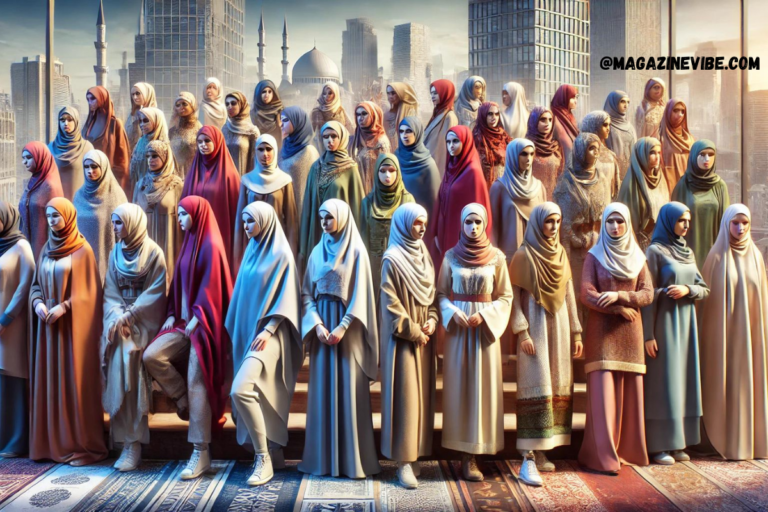Introduction to Hijabhoojup
Hijabhoojup is a term that might sound unfamiliar to many. It seems to derive from a specific context or culture, suggesting a background rich with tradition or a unique social practice. The origin of hijabhoojup is not well-documented, which makes it intriguing and mysterious. This lack of widespread recognition or understanding outside its culture of use suggests that it holds particular significance or a specialized use within that community.
Today, the relevance of hijabhoojup could vary. In its native culture, it might still hold importance or be celebrated as part of heritage and identity. Outside of this, learning about hijabhoojup offers a window into another culture, providing insights into how diverse societies understand and shape their social practices and norms. It shows the value of preserving such unique cultural elements in a rapidly globalizing world.
Exploring the Concept of Hijabhoojup
Hijabhoojup might represent a cultural practice, a traditional belief, or a specific term used within a unique cultural setting. The exact details of what hijabhoojup entails could include rituals, customs, or a social function that is essential within its culture. This could be something that community members participate in regularly or during special occasions, emphasizing its role in societal norms or personal milestones.
The cultural significance of hijabhoojup is profound as it helps in maintaining the continuity of the culture it originates from. It acts as a bridge connecting the past with the present, carrying forward the values and teachings of ancestors. This could involve elements of social cohesion, identity formation, or spiritual beliefs, all central to the community’s way of life.
Within its native cultural context, hijabhoojup is likely viewed with respect and importance. It may be something that community elders teach the younger generations, or it might involve community-wide gatherings or observances. How it is perceived by those within the culture can vary from being a sacred duty to a part of everyday life, depending on its role and the changing dynamics of the culture. Understanding hijabhoojup within its native context offers valuable insights into how cultural practices shape, and are shaped by, the people who uphold them.
The Role of Hijabhoojup in [Relevant Culture/Society]
Hijabhoojup plays a pivotal role in shaping the social norms and traditions of its culture. As a practice or belief system, it might dictate certain behaviors, dress codes, or social interactions that are deemed appropriate or necessary within the community. These norms often serve to strengthen community bonds and ensure the continuity of cultural heritage. Hijabhoojup could also involve ceremonial activities or rituals that highlight significant life events or seasonal celebrations, reinforcing the community’s values and shared history.
The impact of hijabhoojup on the community and interpersonal relationships is significant. It might be a practice that fosters a sense of belonging and identity among community members. By participating in hijabhoojup, individuals connect with their heritage and each other, creating a network of mutual support and understanding. This can be particularly important in maintaining social cohesion and providing a sense of stability and continuity in times of change or adversity. Within families, hijabhoojup might serve as a way to pass down traditions and knowledge, strengthening the bonds between generations and reinforcing family values.
Hijabhoojup and Its Impact on Identity
Hijabhoojup significantly influences both personal and group identity within its culture. This practice or belief could be a core part of what defines an individual’s role in their community and how they perceive themselves within the broader cultural framework. By engaging with hijabhoojup, individuals affirm their connection to their cultural roots and their commitment to the values it represents. This reinforcement of identity is crucial in maintaining cultural uniqueness in a globalized world where homogenization of cultures is prevalent.
For group identity, hijabhoojup acts as a unifying element. It helps in forging a collective identity that transcends individual differences and fosters a strong sense of community. This shared identity is essential for the social cohesion of the group, providing members with a common ground rooted in shared practices and beliefs.
Stories or testimonials from individuals about their experiences with hijabhoojup often highlight its profound impact. For instance, one might hear about how participating in hijabhoojup has given someone a stronger sense of belonging or has deepened their understanding of their cultural heritage. Another individual might recount how hijabhoojup has been a source of comfort and guidance during significant life changes or challenges, illustrating the personal and communal support it provides. These personal stories not only demonstrate the meaningful role of hijabhoojup in individual lives but also its enduring relevance and vitality in maintaining cultural identity.
Comparison with Similar Practices in Other Cultures
Hijabhoojup might have parallels in various cultures around the world, where similar practices hold significant roles. For example, rites of passage such as coming-of-age ceremonies, marriage rituals, or funeral customs can be found in many cultures, each with unique elements but serving similar purposes—marking important life events and transitions.
Similar practices in different cultures might include Native American vision quests, Japanese tea ceremonies, or Scandinavian midsummer festivals. Each of these practices, like hijabhoojup, is deeply ingrained in the culture’s identity and social structure, often accompanied by specific rituals, traditional clothing, or communal gatherings.
The similarities in these practices typically lie in their objectives—to reinforce social bonds, transmit cultural values, and mark significant life milestones. They also often involve a communal aspect, bringing people together to celebrate, mourn, or honor tradition.
However, the differences are found in the specifics of how these practices are carried out. The rituals, symbols, and meanings attached to similar practices vary widely. For example, while hijabhoojup might be a quiet, reflective practice, a similar ritual in another culture could be vibrant and communal. The cultural significance can also vary; some cultures might view these practices as sacred and central to their identity, while others may see them as important but more ceremonial or traditional.
Discussing both the differences and similarities helps highlight the rich diversity in how human societies navigate and celebrate their cultural heritage, showing that while we may differ in expression, many underlying themes of community, identity, and tradition are universally shared.
Modern Perspectives on Hijabhoojup
Over time, the perception and practice of hijabhoojup may have evolved significantly. As societies change, so do the cultural practices that once defined them. Modern influences such as globalization, technology, and social media can transform traditional practices, sometimes preserving them in new forms or causing them to fade.
Changes in the perception of hijabhoojup could include shifts from a sacred practice to a more historical or cultural celebration. Alternatively, there might be a resurgence in its practice as new generations seek connections to their heritage in a rapidly changing world. In some cases, traditional elements of hijabhoojup could be adapted to fit contemporary life, such as incorporating modern themes or technology into traditional frameworks.
Current debates or controversies surrounding hijabhoojup might focus on its relevance in today’s society. Questions could arise about its role in a globalized world where traditional boundaries are less defined. There might be discussions on whether hijabhoojup should evolve to stay relevant or be preserved exactly as it has been for generations. Issues of commercialization, cultural appropriation, or misinterpretation by those outside the culture might also be points of contention.
These modern perspectives are crucial as they determine how hijabhoojup will be maintained and passed down, or altered and adapted, by future generations. They reflect broader societal attitudes toward tradition and change, highlighting the ongoing dialogue between preserving cultural heritage and embracing modernity.
The Future of Hijabhoojup
The future trajectory of hijabhoojup largely depends on how current generations perceive and value this cultural practice. As the world becomes more interconnected, the ways in which traditional practices like hijabhoojup are maintained and adapted could vary greatly.
Predictions or expert opinions on the evolution of hijabhoojup may suggest a range of possibilities. Some experts might believe that hijabhoojup will continue to thrive, bolstered by a renewed interest in cultural heritage among younger generations who seek to rediscover and rejuvenate their cultural traditions. Others might predict that hijabhoojup will evolve in form, possibly blending with other cultural elements or utilizing modern technology to remain relevant and accessible.
Possible changes in its practice could include digital manifestations of hijabhoojup, where virtual reality or social media platforms become new venues for its expression and observance. This could help engage a broader audience and adapt to the lifestyles of a digitally native generation. The cultural importance of hijabhoojup might also shift, moving from a community-centric practice to one that is more individualistic, or vice versa, depending on societal changes and values.
Additionally, there might be efforts to formally preserve hijabhoojup through cultural preservation programs, documentation projects, or academic studies, which could enhance its profile and ensure its survival. Such initiatives could solidify the practice’s role in the cultural identity and heritage of the community, maintaining its significance even as it adapts to a changing world.
Conclusion
Hijabhoojup represents a unique cultural practice deeply rooted in its community’s heritage and identity. This exploration has highlighted its multifaceted role, from reinforcing social norms and traditions to impacting personal and group identities. We’ve seen how hijabhoojup connects individuals to their heritage and to each other, fostering a sense of belonging and continuity within the culture. Changes in the perception and practice of hijabhoojup over time reflect broader social shifts and the impact of modern influences. As debates continue about its relevance and adaptation, hijabhoojup stands as a testament to the dynamic nature of cultural traditions, which evolve in response to changing societal needs and technologies.
Looking ahead, the future of hijabhoojup seems poised between preservation and evolution. Its ability to adapt while maintaining its core significance will likely determine its endurance. Whether through digital platforms, modified practices, or reinforced traditional observances, hijabhoojup will continue to play a crucial role in its community’s cultural fabric. As we reflect on its journey and trajectory, the ongoing engagement with and appreciation for hijabhoojup will serve as a critical factor in its sustained relevance and cherished legacy.
FAQs
Q. What is hijabhoojup?
Hijabhoojup refers to a cultural practice or tradition specific to a certain community, involving rituals, customs, or social functions that are significant within that culture.
Q. Where did hijabhoojup originate?
The origins of hijabhoojup are rooted in the specific cultural and historical context of its community, reflecting its longstanding traditions and heritage.
Q. Why is hijabhoojup important?
Hijabhoojup is important as it helps maintain cultural identity, fosters community bonds, and passes down traditions and values from one generation to the next.
Q. How is hijabhoojup practiced today?
Today, hijabhoojup may be practiced in both traditional and modern forms, depending on the community’s adaptation to contemporary life and the preservation of its original elements.
Q. Are there any modern controversies surrounding hijabhoojup?
Modern controversies might include debates on its relevance, discussions on commercialization, or issues of cultural appropriation, especially as global interactions increase.
Q. Can outsiders participate in hijabhoojup?
Participation rules vary by community; some may welcome outsiders to observe or participate, while others might restrict it to community members to preserve the sanctity and authenticity of the practice.
Q. How can someone learn more about hijabhoojup?
Learning more about hijabhoojup can be achieved through academic research, cultural exchange programs, or by engaging directly with the community through cultural events and educational forums.
Q. What are the future predictions for hijabhoojup?
Predictions vary, but many suggest that hijabhoojup will either evolve with modern influences or be rigorously preserved as a vital part of cultural heritage.
Q. How does hijabhoojup affect the identity of its practitioners?
Hijabhoojup strongly influences both personal and collective identities, reinforcing a sense of belonging, cultural pride, and continuity within the community.
Q. What similar practices exist in other cultures?
Many cultures have practices similar to hijabhoojup, including rituals marking life transitions, community gatherings, or traditional festivals, each adapted to their specific cultural contexts.


